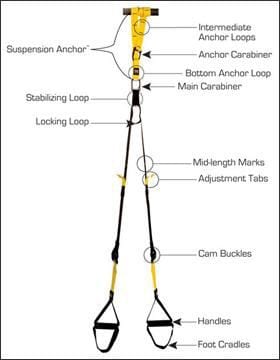Contents
The TRX loops are the perfect home trainer to help you strengthen your muscles, build endurance, burn fat and keep fit. TRX loops work the skeletal muscles of the whole body and are suitable for both beginners and advanced athletes. The main advantage is that they completely eliminate the axial load on the spine, which is contraindicated in people with injuries and disorders of the musculoskeletal system.
Pros and cons of TRX
The main advantages are the absence of axial load, convenient storage (loops, unlike barbells and dumbbells, take up very little space) and a large number of exercises for beginners and trained people (calorizer). However, the TRX is not a universal product that is suitable for people with any injuries, of all ages and weight categories. People with severe back injuries or knee joints cannot be used with it. It will be hard for untrained and very fat people. Before starting classes, you should consult your doctor.
You need to have realistic expectations – you will not build muscle as it requires resistance training and you will not see the cubes on your stomach until you change your diet. But this does not detract from the merits of the TRX, making it one of the safest and most comfortable equipment with which you can train in any conditions – both at home and outdoors.
TRX hinges for different training levels
There are three main levels of training – beginner, trained, and advanced.
Beginners are people who have just started training. They should choose the simplest movements that they can do correctly. For example, squats with loops, glute bridges, push-ups with legs in loops, pulls to the chest. Exercise 2-4 times a week. Use a simple set and rep mode – no supersets, no circles, and no muscle work to failure. It is good to include bodyweight exercises in your workout. If loop push-ups are difficult, do knee push-ups instead.
Trained people for TRX loops can use more complex exercise options. Lunges and squats on one leg, push-ups with one leg in the loop, Australian pull-ups in full range should form the basis of the program. Trainees can use complex approaches, composing exercises in supersets, trisets or circles, as well as add other types of load. The frequency of TRX training remains the same – 2-4 times a week, but to this you can add days of cardio training, swimming and other activities.
The advanced level allows you to use even more complex movements – TRX push-ups, Bulgarian lunges, one-armed pull-ups and pull-ups. The training of the advanced is more intense than that of the trained. Here you can use complex sets, doing a set against the clock, increasing the number of repetitions with each workout, and other progression methods. The frequency of training for the advanced level is 4-6 workouts per week.
With regular practice, the transition from one level to another takes an average of 12 weeks.
TRX Exercises
Let’s list the basic exercises from simple to complex.
- Legs and Buttocks: Squats and lunges with support on loops, gluteal bridge, side lunges, Bulgarian lunges, squats on one leg, King deadlift.
- Back Muscles: Pulls to the chest, body pivots, alligator, front pulls, Y-pulls, one-arm rows, Australian floor pull-ups.
- Chest: TRX push-ups standing, push-ups from the floor (legs in the loops), pulling the arms, pullover with TRX, push-ups from the floor (arms in the loops).
- Shoulder muscles: Y-breeding, watch with one arm abduction, T-breeding.
- Arm muscles: extension and flexion of the arms in the slope.
- Core Muscles: Plank, Pivot Plank, Crunch Dips, Climber, Reverse Climber, Fold, Spiderman.
The more exercises you know and can do, the better. The basic exercises for each muscle group can be found in the following videos.
Exercises for the legs, shoulders and abs can be seen in the video clip “TRX Loops – Effective Exercises for the legs, abs and shoulders” (Your Body Mind):
Exercises for the chest and back you can see from the video clip “TRX exercises for the chest and back at home and outdoors” (Your Body Mind):
Remember that TRXs are safe, but they do not guarantee protection against injury in the event of improper exercise. Learn the technique before you start exercising.
Beginner training example
Before starting the main part, do a light one of articular gymnastics and bodyweight exercises like squats, knee push-ups, lunges, various swings and rotations.
To keep your body from getting used to the load, the number of repetitions or sets will change from week to week:
Week 1: 3 sets of 8 reps
Week 2: 3 sets of 10 reps
Week 3: 4 sets of 10 reps
Week 4: 4 sets of 12 reps.
The workout itself consists of the following exercises:
- Squats;
- Gluteal bridge;
- Cravings for the chest;
- Standing push-ups;
- Y-dilutions;
- Plank (legs in loops).
Finish the workout by stretching all working muscles.
After a month of practice, you can replace the light exercises with more challenging options or add new movements to the program.
Build your workouts on the principle of the whole body at one time. This will help you burn more calories, master and hone your movement technique, improve muscle endurance and move to a new training level (calorizator). There won’t be many exercises available at the start of your class, but don’t despair. Starting with simple movements, you will master more complex variations over time. Everything has its time, most importantly, patience and regular training.










